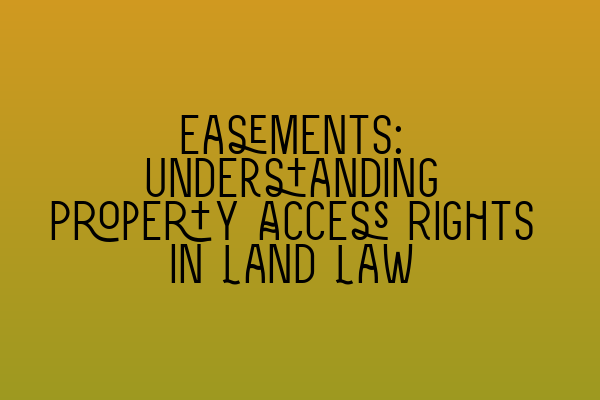Easements: Understanding Property Access Rights in Land Law
When it comes to property ownership, understanding the rights and obligations that come with it is crucial. One area that often causes confusion is easements, which are access rights granted to someone over another person’s land. In this blog post, we will delve into the intricacies of easements, exploring what they are, how they are created, and the implications they have for property owners. Whether you are a homeowner, a property investor, or a legal professional, this comprehensive guide will provide you with the knowledge you need to navigate easements in land law.
What are Easements?
An easement is a legal right to use another person’s land for a specific purpose. It allows the holder of the easement (known as the dominant owner) to benefit from the land of another person (known as the servient owner) without owning it. Easements primarily relate to private property and can be created through various means, such as express grant, implied grant, or statutory prescription.
Common examples of easements include rights of way, which grant access to a property over someone else’s land, and rights of light, which ensure that a property receives adequate natural light. Easements can also involve the right to run utilities (e.g., gas, water, or electricity) or the right to drain water onto adjacent land.
Creating Easements
Easements can be created in several ways, depending on the circumstances and the intentions of the parties involved. Understanding the different methods of creating easements is essential for both property owners seeking to grant access rights and those looking to benefit from such rights.
Express Grant
An easement can be expressly granted by the servient owner to the dominant owner through a written agreement, such as a deed. The agreement should clearly outline the scope and nature of the easement, including any limitations or conditions. Express grants are the most common way of creating easements and provide both parties with certainty and legal protection.
For example, if you require access to your property through a neighbor’s driveway, an express grant agreement can formalize this arrangement and ensure your right of way is legally recognized and enforceable.
Implied Grant or Reservation
Easements can also be created through implied grant or reservation, which occur when there is an implied intention for an easement to exist between the parties.
An implied grant may arise when there is an existing use of land that is necessary for the reasonable enjoyment of another property. For instance, if a landlocked property has historically been accessed through a neighboring property, an implied easement of necessity may be established.
On the other hand, an implied reservation arises when the owner of land sells part of their property but retains certain rights over the land they have sold. These retained rights are implied easements reserved for the benefit of the seller.
Prescription
Easements can also be acquired through statutory prescription, which is a legal mechanism that allows for the acquisition of certain rights over another person’s land through long-term consistent use. The Prescription Act 1832 provides a framework for establishing prescriptive easements, which require uninterrupted use for at least 20 years without force, secrecy, or permission.
If a property owner can demonstrate that they have been using another person’s land for a specific purpose openly and without objection for the required period, they may be able to establish a prescriptive easement. However, it is important to seek legal advice and gather sufficient evidence to support a prescriptive claim, as the burden of proof rests with the claimant.
Implications for Property Owners
Easements have significant implications for both the dominant owner and the servient owner. As a property owner, understanding the impact of easements on your land and your rights is crucial for effective property management.
For the servient owner, granting an easement means dedicating a portion of their land to the benefit of another. This may restrict their use and enjoyment of the property and could limit their future development options. Therefore, it is essential for servient owners to carefully consider the terms and conditions of any easement before granting it to ensure their interests are protected.
As a dominant owner, having an easement grants you certain rights and privileges over another person’s land. However, it is important to understand the scope and limitations of the easement to avoid any potential conflicts or misunderstandings. Additionally, being aware of the maintenance responsibilities and any financial obligations associated with the easement is crucial to ensure its continued validity.
Conclusion
Easements play a significant role in property access rights under land law. Whether you are seeking to grant an easement or benefiting from one, understanding the methods of creation and the implications for both parties is essential for effective property management. By familiarizing yourself with the different types of easements and their requirements, you can navigate easements with confidence and ensure your rights are protected.
If you have any questions or require legal advice regarding easements or any other property law matters, do not hesitate to reach out to our team of experienced solicitors at SQE Property Law & Land Law. We are here to provide you with expert guidance and support.
Related Articles:
- Updates in UK Property Laws: Key Changes and Implications
- Legal challenges in property transactions: A comprehensive guide
- Navigating Lease Laws in the UK: Essential Guidelines for Tenants and Landlords
- Dominate Property Law Questions: Avoiding Common Pitfalls
- Land Law Revision Tips: Ace Your Exam Preparation
